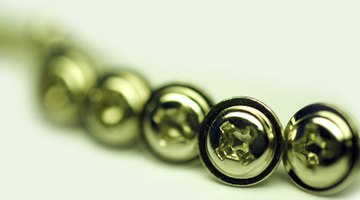How to Fix a Stripped Screw Head
Stripping a screw head is a frustrating experience. Using the correct tools will help avoid problems from the start. Unfortunately, stripping a screw head is made even easier with power tools and emphasis placed on quantity instead of quality. Use an electric screwdriver.

Things You Will Need
- Screwdrivers
- Power drill and bit
- High-speed rotary tool
- Penetrating oil
- Liquid soap or wax
- Screw extractor set
Take a few moments to insure a good fit, proper pressure, and execution on each and every screw insertion or removal. Then take a break. Rest a moment. Collect your thoughts. Begin again with renewed vigor.
-
Pull the screw out with a pair of vice grips. If enough of the head is exposed, simply twist it and use an alternative screw in place of the damaged one.
-
If the screw is flush before it strips, try a drop of penetrating oil or liquid soap or wax. A hard quick blow from a hammer might loosen the damaged screw head.
-
Repair the screw head with a small high-speed rotary tool such as a Dremel tool to widen and repair screw slot. Try a little penetrating oil and use an oversized screwdriver that fits the new slot. Use pressure and carefully back out.
-
Remove the screw by drilling a small hole through the damaged head, then use the appropriately sized screw extractor such as "Easy Out" to remove the screw.
Tip
Always drill a starter hole in hard wood before attempting a screw insertion Attach brass hinges with steel screws first. Then replace with brass screws. Always use the correctly matched screwdriver for the screw. Avoid tipping the drill when power driving screws. Keep a steady downward pressure with the screwdriver to keep the head seated in the screw.
Warning
Do not use electric power tools while standing in water.
Discard any defective screws before using.
Avoid power tool slippage and getting too close to clothing or skin.
Wear eye protection while drilling.
References
Tips
- Always drill a starter hole in hard wood before attempting a screw insertion
- Attach brass hinges with steel screws first. Then replace with brass screws.
- Always use the correctly matched screwdriver for the screw.
- Avoid tipping the drill when power driving screws.
- Keep a steady downward pressure with the screwdriver to keep the head seated in the screw.
Warnings
- Do not use electric power tools while standing in water.
- Discard any defective screws before using.
- Avoid power tool slippage and getting too close to clothing or skin.
- Wear eye protection while drilling.
Writer Bio
Writing from his Cape Cod home alcove, Thomas Edward won American Express' National Humor Contest and wrote "Stern's Reminder," a nautical fiction, in 1999. His first professional publication in 2005, "My Fathers Who Art in Heaven," was followed by short stories in New England One magazine. Edward holds an M.S. in civil (environmental) engineering from the University of Cincinnati.
Photo Credits
- screw army image by Krasser from Fotolia.com
- screw army image by Krasser from Fotolia.com
More Articles



